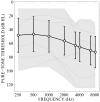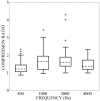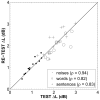Level discrimination of speech sounds by hearing-impaired individuals with and without hearing amplification
- PMID: 21187751
- PMCID: PMC3108890
- DOI: 10.1097/AUD.0b013e318202b620
Level discrimination of speech sounds by hearing-impaired individuals with and without hearing amplification
Abstract
Objectives: The current study was designed to see how hearing-impaired individuals judge level differences between speech sounds with and without hearing amplification. It was hypothesized that hearing aid compression should adversely affect the user's ability to judge level differences.
Design: Thirty-eight hearing-impaired participants performed an adaptive tracking procedure to determine their level-discrimination thresholds for different word and sentence tokens, as well as speech-spectrum noise, with and without their hearing aids. Eight normal-hearing participants performed the same task for comparison.
Results: Level discrimination for different word and sentence tokens was more difficult than the discrimination of stationary noises. Word level discrimination was significantly more difficult than sentence level discrimination. There were no significant differences, however, between mean performance with and without hearing aids and no correlations between performance and various hearing aid measurements.
Conclusions: There is a clear difficulty in judging the level differences between words or sentences relative to differences between broadband noises, but this difficulty was found for both hearing-impaired and normal-hearing individuals and had no relation to hearing aid compression measures. The lack of a clear adverse effect of hearing aid compression on level discrimination is suggested to be due to the low effective compression ratios of currently fit hearing aids.
Figures











References
-
- Amitay S, Irwin A, Hawkey D, et al. A comparison of adaptive procedures for rapid and reliable threshold assessment and training in naive listeners. J Acoust Soc Am. 2006;119:1616–1625. - PubMed
-
- American National Standards Institute Specification of Hearing Aid Characteristics. 2003 ANSI S3.22-2003.
-
- Bacon S, Oxenham A. Psychophysical manifestations of compression: Hearing-impaired listeners. In: Bacon S, Fay R, Popper A, editors. Compression: From cochlea to cochlear implants. Springer Verlag; New York: 2004. pp. 107–152.
Publication types
MeSH terms
Grants and funding
LinkOut - more resources
Full Text Sources
Medical

